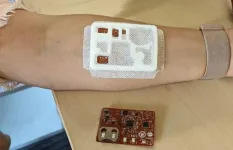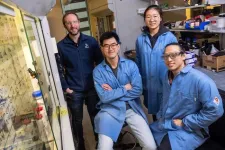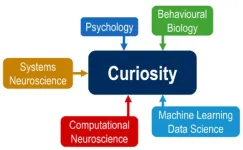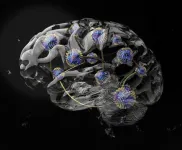(Press-News.org) – The National Institutes of Health (NIH) has awarded $1.1 million to a team led by Worcester Polytechnic Institute (WPI) researcher Ulkuhan Guler to develop a first-of-its-kind wearable sensor for premature infants that will address racial bias in healthcare by monitoring oxygen levels two different ways and correcting the measurements to account for variations in skin color.
The four-year project will create a convenient, affordable, noninvasive sensor about the size of a bandage that will enable infants at risk of lung disease to leave hospitals sooner and be accurately monitored at home, said Guler, an associate professor in the Department of Electrical and Computer Engineering, and principal investigator on the project.
“Premature infants are at risk of respiratory distress, and oxygen monitoring is critical to their care so that they can leave hospitals and go home,” Guler said. “Some tools widely used at home to monitor oxygenation, however, do not accurately measure oxygen levels in infants with pigmented skin tones. There is a great need for new technology that mitigates the impact of racial bias in measurements and provides important information to the clinicians who are treating these infants.”
Guler will collaborate on the research with co-investigators Dr. Lawrence Rhein, associate professor and chair of the Department of Pediatrics at UMass Chan Medical School, and Bige Unluturk, assistant professor of electrical engineering and biomedical engineering at Michigan State University.
The researchers will develop a wireless patch with a miniaturized low-power electronic sensor that will use light to measure blood oxygen levels two different ways: A transcutaneous blood gas monitor will sense oxygen gases diffusing through the skin, and a pulse oximeter will measure reflected or refracted light to determine oxygen saturation in hemoglobin, a protein found in red blood cells.
The sensor will transmit data to a small communications hub that could be placed on an infant’s crib or carrier. A bias-mitigation algorithm to correct for inaccurate measurements in people of color will run on the hub. The researchers will integrate hardware and software into a system that will be pilot tested on adults and infants in a clinical setting.
The project addresses a complex health and equity problem. Doctors need to assess a respiratory patient’s ability to take in oxygen and distribute it to the body’s tissues. The best way to do that is by drawing blood from an artery, but the process is invasive, painful, and provides data for just one point in time.
Pulse oximeters, including those that clip onto a fingertip, use indirect methods to estimate arterial oxygen levels, but the technology has been shown to underestimate oxygenation in patients with pigmented skin. A retrospective study of 7,126 patients during the COVID-19 pandemic showed that pulse oximetry overestimated oxygen saturation among Asian, Black, and Hispanic patients compared to White patients. The overestimation led to a failure to identify Black and Hispanic patients who qualified for treatment.
A separate study of 294 premature infants showed that pulse oximetry consistently underestimated oxygen levels and hypoxemia, or abnormally low oxygen levels, in Black infants compared to White infants. In addition, Guler said, pulse oximetry fails to detect excessive oxygenation, or oxygen poisoning, in infants who receive oxygen therapy.
The researchers’ project builds on Guler’s previous work to develop better, more accurate oxygen sensors. She received a prestigious CAREER Award from the National Science Foundation in 2022 for development of a noninvasive sensor for infants that indirectly measures oxygen and carbon dioxide levels in arterial blood. Her work is the subject of several patent applications. Guler, Rhein, and Unluturk recently presented their research at “New Directions in Transcutaneous Blood Gas Monitoring,” a WPI symposium they organized.
Although the initial focus of the new research is on infants with respiratory issues, the sensor technology also could be used to monitor adults with respiratory conditions such as asthma and chronic obstructive pulmonary disease (COPD).
“Improved sensors have the potential to help many patients, not just premature infants,” Guler said. “If doctors could accurately, effectively, and continuously monitor patients at home, they could potentially discharge premature babies and adults from hospitals earlier and reunite families, which could improve health outcomes and prevent health disparities that can have lifelong consequences.”
END
Worcester Polytechnic Institute researcher leads project to develop oxygen sensor for premature infants of color
NIH funds Ulkuhan Guler’s work to build technology that will use dual-mode oxygenation measurements and a novel algorithm to mitigate the skin-color bias for at-risk infants
2023-11-13
ELSE PRESS RELEASES FROM THIS DATE:
Fluorine catch-and-attach process could boost drug efficiency
2023-11-13
HOUSTON – (Nov.13, 2023) – When it comes to chemical reactions, fluorine has a reputation as a ‘magic bullet atom’ for its ability to increase a drug’s absorption and prolong its lifetime. However, traditional methods of adding it to compounds entail expensive materials and can be difficult to pull off.
Rice University scientists developed a reliable and cost-effective process of adding fluorine to molecules for increased pharmaceutical drug efficiency using an iron and ...
New assay could revolutionize detection and treatment of acute myeloid leukemia
2023-11-13
Philadelphia, November 13, 2023 – A novel assay that detects a unique molecular marker in patients with acute myeloid leukemia (AML) may revolutionize the way this disease is detected and treated according to a new report in The Journal of Molecular Diagnostics published by Elsevier. This assay may improve detection of AML driven by KMT2A gene fusions and may affect treatment decision-making, assessing response to therapy, and long-term surveillance.
AML is a rare, aggressive blood cancer diagnosed in around 120,000 individuals worldwide each year. Detecting residual disease during treatment is essential for determining prognosis and ...
Curiosity and pure maths
2023-11-13
The German Research Foundation (DFG) will be funding a new Research Training Group (RTG) at the University of Göttingen from next year. The RTG "Curiosity" is based at the Faculty of Biology and Psychology. Funding is expected to total around 7.8 million euros over the following five years. In addition, the DFG has extended the funding for the RTG "Fourier Analysis and Spectral Theory" at the Faculty of Mathematics and Computer Science by five years. The award for this RTG totals around 4.5 million euros over the extended funding period.
Curiosity is broadly defined ...
Limited positive childhood experiences linked to higher binge-eating risk in college
2023-11-13
New findings from the University of Houston Department of Health and Human Performance reveal a significant association between a lower number of positive childhood experiences and a higher prevalence of binge-eating disorder characteristics, as well as lower scores for intuitive eating.
Binge eating, which includes consuming a substantial amount of food within a brief timeframe and experiencing a loss of control, is linked to adverse weight-related health effects and challenges in mental well-being. Intuitive eating, ...
Rensselaer Polytechnic Institute Nanotechnology expert Nikhil Koratkar named American Physical Society Fellow
2023-11-13
Nikhil Koratkar, Ph.D., John A. Clark and Edward T. Crossan Professor of Engineering at Rensselaer Polytechnic Institute, has been named a fellow of the American Physical Society (APS). Koratkar was recognized for his pioneering contributions to the field of nanoscale science and technology and the use of nanoscale materials in composites and energy storage devices. Each year, no more than 0.05% of the society membership is recognized by their peers for election to the status of fellow of the American Physical Society.
The APS Fellowship Program recognizes members ...
Children’s National Hospital selected as member of ARPA-H Investor Catalyst Hub spoke network
2023-11-13
WASHINGTON, D.C. (Nov. 13, 2023) – Children’s National Hospital was selected as a spoke for the Investor Catalyst Hub, a regional hub of ARPANET-H, a nationwide health innovation network launched by the Advanced Research Projects Agency for Health (ARPA-H).
The Investor Catalyst Hub seeks to accelerate the commercialization of groundbreaking and accessible biomedical solutions. It uses an innovative hub-and-spoke model designed to reach a wide range of nonprofit organizations and Minority-Serving Institutions, with the aim of delivering scalable healthcare outcomes for all Americans.
“The needs of ...
Antiviral treatment is largely underused in children with influenza, study findings show
2023-11-13
Despite national medical guidelines supporting the use of antiviral medications in young children diagnosed with influenza, a new study reports an underuse of the treatment.
“Trends in Outpatient Influenza Antiviral Use Among Children and Adolescents in the United States” was published in Pediatrics, a peer-reviewed journal of the American Academy of Pediatrics.
“Antiviral treatment, when used early, improves health outcomes with influenza,” said lead author and principal investigator James Antoon, MD, PhD, MPH, assistant professor of Pediatrics and Hospital ...
Twisted magnets make brain-inspired computing more adaptable
2023-11-13
A form of brain-inspired computing that exploits the intrinsic physical properties of a material to dramatically reduce energy use is now a step closer to reality, thanks to a new study led by UCL and Imperial College London researchers.
In the new study, published in the journal Nature Materials, an international team of researchers used chiral (twisted) magnets as their computational medium and found that, by applying an external magnetic field and changing temperature, the physical properties of these materials could be adapted to suit different machine-learning tasks.
Such an approach, known as physical reservoir ...
New heat map charts unequal civic opportunity in the US
2023-11-13
People in many parts of the United States possess few chances for the robust community engagement that underpins healthy democracies, according to a new report that for the first time maps civic opportunity across the country.
The heat map created by Johns Hopkins University’s SNF Agora Institute, reveals patterns of inequality in civic opportunity tied to race, class, immigration status and education. Researchers also found that a great deal of civic engagement happens through local faith institutions and social and fraternal organizations, not D.C.-based advocacy organizations that tend to carry political clout.
The report is the initial phase ...
One step closer to Mars immigration
2023-11-13
Immigration to and living on Mars have long been depicted in science fiction works. But before dream turns into reality, there is a hurdle man has to overcome -- the lack of essential chemicals such as oxygen for long-term survival on the planet. However, hope looms up thanks to recent discovery of water activity on Mars.
Scientists are now exploring the possibility of decomposing water to produce oxygen through electrochemical water oxidation driven by solar power with the help of oxygen evolution reaction (OER) catalysts. The challenge is to find a ...
LAST 30 PRESS RELEASES:
New expert guidance urges caution before surgery for patients with treatment-resistant constipation
Solar hydrogen can now be produced efficiently without the scarce metal platinum
Sleeping in on weekends may help boost teens’ mental health
Study: Teens use cellphones for an hour a day at school
After more than two years of war, Palestinian children are hungry, denied education and “like the living dead”
The untold story of life with Prader-Willi syndrome - according to the siblings who live it
How the parasite that ‘gave up sex’ found more hosts – and why its victory won’t last
When is it time to jump? The boiling frog problem of AI use in physics education
Twitter data reveals partisan divide in understanding why pollen season's getting worse
AI is quick but risky for updating old software
Revolutionizing biosecurity: new multi-omics framework to transform invasive species management
From ancient herb to modern medicine: new review unveils the multi-targeted healing potential of Borago officinalis
Building a global scientific community: Biological Diversity Journal announces dual recruitment of Editorial Board and Youth Editorial Board members
Microbes that break down antibiotics help protect ecosystems under drug pollution
Smart biochar that remembers pollutants offers a new way to clean water and recycle biomass
Rice genes matter more than domestication in shaping plant microbiomes
Ticking time bomb: Some farmers report as many as 70 tick encounters over a 6-month period
Turning garden and crop waste into plastics
Scientists discover ‘platypus galaxies’ in the early universe
Seeing thyroid cancer in a new light: when AI meets label-free imaging in the operating room
Neutrophil-to-lymphocyte ratio may aid risk stratification in depressive disorder
2026 Seismological Society of America Annual Meeting
AI-powered ECG analysis offers promising path for early detection of chronic obstructive pulmonary disease, says Mount Sinai researchers
GIMM uncovers flaws in lab-grown heart cells and paves the way for improved treatments
Cracking the evolutionary code of sleep
Medications could help the aging brain cope with surgery, memory impairment
Back pain linked to worse sleep years later in men over 65, according to study
CDC urges ‘shared decision-making’ on some childhood vaccines; many unclear about what that means
New research finds that an ‘equal treatment’ approach to economic opportunity advertising can backfire
Researchers create shape-shifting, self-navigating microparticles
[Press-News.org] Worcester Polytechnic Institute researcher leads project to develop oxygen sensor for premature infants of colorNIH funds Ulkuhan Guler’s work to build technology that will use dual-mode oxygenation measurements and a novel algorithm to mitigate the skin-color bias for at-risk infants








